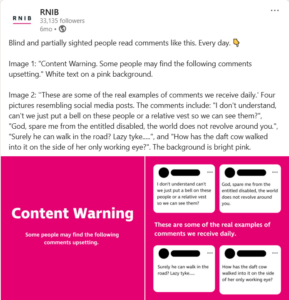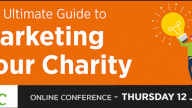Marketing, Marketing & communications
Social media’s gone wild: Looking after yourself and your community
Looking after yourself and your team online is key to being able to empower your community.
Navigating social media right now feels like a bit more trouble than it’s worth. With constantly shifting trends, the rise of disinformation, and increasing online hate toward charities, to say as comms professionals we’re juggling a lot is an understatement.
With many charities leaving X, and Meta having changed its policies regarding fact-checking, we’re now in a strange position where we’re figuring out new platforms or trying to make the old ones work. It’s tough work and it can be incredibly overwhelming, especially because part of our role is trying to keep up with everything, which is physically impossible!
Whilst we face these challenges, it’s crucial that we look after ourselves and our people. Even though it can often feel like we don’t get a break from our roles, it’s important to try and figure out a way we can put our wellbeing first. The pressure to keep up can be overwhelming, but your mental health should never be sacrificed in the process. Social media is there to amplify your charity’s voice and mobilise your community – but it’s not worth burning yourself out for.
By setting healthy boundaries and cultivating a better relationship with social media, you’re more likely to come up with fresh ways to support your community during these challenging times. With that in mind, I’ve put together strategies to help you set boundaries and focus on what you can control.
It could be time for a digital detox
If you’re someone who has to stay active on social media for work, it’s so important to set boundaries and carve out time to unplug. Since social media is part of our role, taking time off when you’re not at work is even more important. The bombardment of information and opinions that come with social media can make your brain fry, so it’s crucial that we take a step back and give ourselves some time to think and digest.
I encourage you to block out a day or two over the weekend to go off-grid. It may seem daunting at first, however, it’s a great way just to take that pressure off and come back to work feeling refreshed and ready to find out what you missed.
Review your active platforms
If you’re finding platforms difficult to use or even toxic, it’s important that you review how this platform is benefiting your charity and its beneficiaries. Deciding whether to stick with a platform, move to another, or even step back entirely can be daunting, but the key is to prioritise your mission and community’s wellbeing over the noise. Maintaining a healthy social media presence means more than just jumping on the latest trends – it’s about choosing platforms that align with your values and protect your supporters. Setting clear boundaries around platform engagement and reevaluating where your energy is best spent can help ensure your charity’s voice is heard without losing sight of your goals.
If you see that a platform is no longer serving your charity, it may be time to speak to your managers about putting together a new strategy to the Board.
Share the load
Remember you’re not alone – others are there to support you. In your organisation and out – could be formal or informal. Are there any professional associations or groups to join? Or peer support networks? Charity Comms has a social media network that you can join, check it out here.
Getting reinspired
Sometimes, when there are too many options, we can end up actually just doing nothing. Trends come and go so fast, that by the time you’re ready to hop on, it’s been and gone. I imagine it’s sort of like watching Formula 1, by the time you’ve figured out what’s going on, the game’s already over! It’s a total minefield.
One way to break out of this cycle is by scheduling time to learn and think about new ways to approach social media. It’s all about re-igniting that spark as a charity communicator. Jump into a course, attend a conference (DSC has a marketing conference coming up!), and connect with other comms pros. Or you could even read a book! It will help you feel reinspired and ready to come up with new ideas for your organisation.
Reframing hate comments
You would think that encountering hate and abuse online for charities is pretty rare, right? Wrong. According to a recent report by Social AF, 100% of charity communicators surveyed reported having encountered abuse and hate online. With the current state of social media, this is sad but not surprising.
One charity that frequently faces hate in their comment section is RNIB, the Royal National Institute for Blind People, and I think there’s a lot we can learn from them. Lately, the RNIB team has really been nailing their approach to social media. One of the ways they’ve been making a difference is by resharing some of the hateful comments they receive in response to videos and images of blind people trying to navigate a society that isn’t built for them. See the image or alt text below.
(Text includes: Blind and partially sighted people read comments like this. Every day.
Image 1: “Content Warning. Some people may find the following comments upsetting.” White text on a pink background.
Image 2: ”These are some of the real examples of comments we receive daily.’ Four pictures resembling social media posts. The comments include: “I don’t understand, can’t we just put a bell on these people or a relative vest so we can see them?”, “God, spare me from the entitled disabled, the world does not revolve around you.”, “Surely he can walk in the road? Lazy tyke…..”, and “How has the daft cow walked into it on the side of her only working eye?”. The background is bright pink.)
They’ve shared these shocking comments to highlight just how common it is for blind and partially sighted people to be abused online. I think it’s such a powerful example of how charities can confront online trolls and turn it into an opportunity to raise awareness for their cause. They’ve even put together a resource with tips for anyone who’s been called an ableist – check it out here.
This approach to dealing with unwanted comments is brilliant. While it might not be something every charity can do, it can help us rethink how we respond to hate. For example, we could use these comments to fuel our passion and drive for the causes we’re working toward.
Setting community guidelines
Another way that you can feel more empowered in your role whilst simultaneously protecting your community is by creating guidelines for your online community. By setting clear, positive guidelines that protect your community, you can make your online space a safe place to be. With these rules in place, toxic comments and hate speech can be nipped in the bud, protecting your beneficiaries and making sure supporters feel welcome.
Start by thinking about your charity’s values and mission – what kind of community do you want to build? Be specific about what’s not allowed, like hate speech, discrimination, or trolling, and outline clear actions for violators like warnings, bans, etc. Make sure your rules are easy to understand and accessible, so everyone knows where the line is, and you know exactly what to do if someone breaks the rules.
Make sure you have a good policy to stand by
Finally, it’s really important to have an up-to-date social media policy that you can rely on – Charity Comms has a template you can use, find it here. It’s essential for your leadership team or managers to set clear guidelines so you know exactly how to handle a comms crisis. Having this in place will help you feel more supported by your organisation and take some of the pressure off. Good social media management practices are crucial for organisations, especially now when we’re facing challenges like widespread disinformation and online community polarisation.
This policy needs to include what happens in a situation where your charity falls victim to online abuse, i.e. what is the procedure that will take place. Include what to do if something seriously dangerous happens, like a threat to one of your staff or volunteers. In this case, you may need to report this to the Charity Commission and the police.


